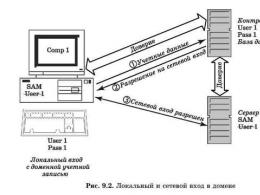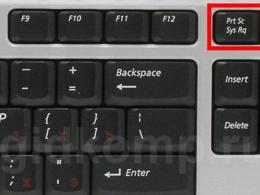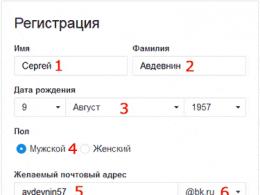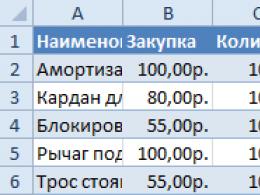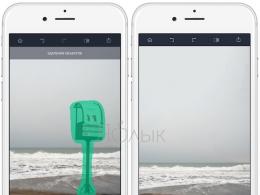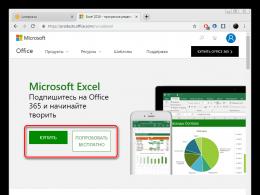How to optimize windows 8.1 for fast performance. Identification of applications using a large number of resources
At creating Windows 8.1 developers relied on the most modern Computer techologies. Nevertheless, this OS works fine on older computers with a fairly modest configuration: the requirements for hardware the "eight" are almost the same as those of Windows Vista.
Unlike solid state drive, for improvement work hard The disk must be defragmented immediately after installing the system. In this case, instead of the standard defragmentation utility, it is better to use the more powerful and functional free program Defraggler. It will analyze the file system more efficiently and better eliminate file defragmentation, which will make it possible to slightly increase system performance.
The ideal option is to install and run Defraggler immediately after installing the OS. And although some skeptics may argue that the differences in computer performance after defragmenting disk space and placing system files in adjacent areas are minimal, with a comprehensive optimization of the system, the combination of such trifles adds up to the best performance.
Cleaning up junk files
Instead of another system utility, Windows Disk Clenup, which removes excess from the disk, is better to use free program CCleaner.
It can be used to perform the following operations:
- Delete unnecessary unused files;
- Optimize the boot process;
- Check the system registry for errors;
- Completely remove installed programs.
Driver updates
Many issues related to "slowdown" of the OS can be completely avoided if you install updated drivers for the equipment installed on your computer. To check if the drivers can be updated automatically, open the charms bar, and select "Computer Settings". Click on "Change settings", go to the item Windows Update.
We click "Check for updates", we look at what is available to us at the moment.
Configuring system settings
The performance of Windows 8.1 can be greatly improved by changing the visual effects settings and changing the virtual memory size. Go to the "Control Panel", select "System" and then "Advanced system settings".
In the "System Properties" window that appears, look for the "Advanced" tab, in it the "Performance" section, then click the "Settings" button.
In the new window, you can set the switch to the maximum OS speed mode. Users who wish to keep the visuals can tick them off.
By selecting the “Advanced” tab, you can change the volume virtual memory and swap file.
Disabling unused parts
If you want your old computer worked faster under Windows control 8.1, it's better to disable the following:
- Unused in this moment equipment;
- Extra services and programs from startup;
- Tiles that do not carry important information.
On the Metro home screen, select any tile, click right click mouse and select the appropriate item from the context menu.
It is completely painless to turn off tiles that are active by default, without which it is quite possible to do.
Computers running operating systems Windows systems 8.1 or Windows RT 8.1 automatically optimizes its performance according to the default settings, so you can usually be sure that your PC has better performance. But sometimes situations arise when computer is too slow and you start looking for the causes of "braking", for their manual elimination.
Despite the fact that the automatic performance optimization function is integrated into Windows 8.1, Microsoft includes separate utilities in the operating system that should help the user in solving certain problems. The optimization process itself is very simple and you do not need special knowledge to manually increase the performance of your computer.
3 the best way The tips below will help you optimize your Windows 8.1 PC or tablet so you can use them on a regular basis.
Let's start with the most important and effective way. 1 way:
Scan your computer for viruses and malware. Viruses and malware are perhaps the biggest reason for your computer to slow down. A virus can enter a computer from any source - either when visiting an infected site through a browser, or through a downloaded file, or from an infected media such as a CD, DVD, flash drive or memory card. Viruses and malware can be found in applications and files of any purpose and format, so it is very important to always be on your guard so as not to infect your computer.
Viruses and malware can slow down your PC different ways and when infected, they can interfere with a range of normal activities. In addition, viruses can give hackers access to your personal data or completely block the ability to use certain functions.
Windows 8.1 comes preinstalled Windows application Defender, which is Microsoft's own antivirus product. The application is designed to protect your computer from infection by any kind of viruses and malware. Although Defender updates itself and automatically scans your computer for infections, viruses can disable virus detection mode in Defender danger or limit automatic update and scanning.
Reminder: If you use third-party antivirus software to protect your Windows 8.1 PC, we recommend that you also use this way optimizing PC performance.
1. Launch Windows Defender or any other antivirus software (if you have installed it) through the Control Panel.
2. Update the database of known viruses through the built-in function of the antivirus product. At the same time, you will receive the most "fresh" updates with the signatures of the newest viruses.
3. After updating the anti-virus databases, run a full computer scan for viruses.
Reminder: in quick mode Windows scan Defender scans your computer a little faster and saves you a couple of minutes compared to a full scan.
4. Upon completion antivirus check, if viruses or malware are detected, remove them immediately with anti-virus software.
The first method will help you get rid of malicious objects on your computer and restore (increase) its performance.
Method 2: Remove unnecessary system files
Windows 8.1 stores on the computer's hard drive a large number of system files to perform future tasks, but subsequently never deletes them and the files take up space on your hard drive. Often, an array of unnecessary system files can take up to several gigabytes of disk space. Storing a large array junk files may cause slower computer performance and slower response times in various tasks.

Windows allows you to clean up disk space by deleting unnecessary files and cleaning specialized file storages such as browser internet cache, temporary files ( Temp folder) and a basket (recycle bin).
1. To clear file vault data, search the Start Screen search bar for the following term: "" .
2. In the search results, you will see one of these items " Free up space by deleting unnecessary files" or " Disk Cleanup". Click on one of these links.
Reminder: if you do not find anything like this in the search results, then you will need to enable access to the administration utilities. Read our separate guide on how to do this.
3. Utility window " Disk Cleanup' will open on your desktop. Select drive C from the drop-down menu and click OK.
4. Next, the utility will automatically calculate the disk space that you can free up. After the calculation, you will be given full list files (in categories) that you can delete to free up disk space.
5. Select all files. There may be files from the trash, setup files, temporary files and more. Sometimes the sum of the files of these categories can reach several gigabytes. By ticking the categories you don't need files from, you'll see exactly how much disk space will be freed up at this stage.
7. At the end of the process, you will receive a message that the place is on local disk(in our case it was drive C) is freed.
8. You can repeat the described procedure for all logical drives into which your hard drive is "split".
3 way: defragmentation
With a high degree of probability, your computer is equipped with a hard drive, which, in a sense, is the brain of the PC, storing data for a long time, writing them in a certain sequence in parts on the surface of the disk drive. At the same time, digital data consisting of bytes and bits can be placed in different sections (sectors) hard drive.
As soon as the process of writing files to disk begins, they are divided into parts by sectors, which from the outside may look like chaos. Data is not written sequentially (continuously) and this results in slower response times when accessed from the PC operating system. Microsoft has traditionally included a utility in the new OS that should help you organize your data and provide more quick access to them.

The Disk Defragment utility sorts (moves) data blocks in such a way that when accessing data it is easier, and accordingly, the OS Windows is faster responded to your requests.
1. Go to the Start screen of the operating system and simultaneously press the buttons " Windows key + I» or touch gesture swipe left and select the menu item " Settings».
2. The settings menu window will open Settings". Select in it " Tiles».
3. The option to manage dynamic blocks will open. In it, activate the display mode of administration utilities " Show administrative tools by moving the slider to the right.
4. Now press the button combination " Windows key + S” or swipe right and select the option “ Search».
5. In the search dialog, type " defragment».
6. As a result, all disk devices that can be defragmented. Here you can select the disk you are interested in.
7. Dialog box " Optimize Drives' will open on your desktop.
8. Now select the C drive and click the " Analyze» to see the status of the device.
9. After analyzing the disk, which can take several tens of seconds, you will know if defragmentation is required this disk or not. If the OK status is displayed, then you do not need to defragment the disk.
10. Click the " Optimize” to start the optimization process.
Reminder: The optimization process may take several hours, depending on the speed of your computer.
11. As soon as the operation is completed, you will immediately feel that the performance of the computer has increased, especially when accessing data stored on the computer's hard drive.
12. If necessary, defragment all logical drives.
How often should the described operations be performed?
You may be wondering how often you need to perform each of the methods described to increase computer performance. Next, we give an answer for each of the three ways:
1. You can scan your computer once a week, but update anti-virus database Windows Defender follows daily;
2. Run Disk Cleanup Utility Disk Cleanup can be done once a week or even once every 2 weeks. Running the utility more frequently may not produce results.
3. Defragmentation is not a process that needs to be run regularly (daily or weekly). Running the utility once a month or even once every two months can provide optimal disk performance for your computer.
By regularly performing one of the described methods or by performing them one by one, you can seriously increase the performance of your computer.
Microsoft, when introducing Windows 8, focused on improving the performance and optimization of the new operating system compared to its predecessors. In my opinion, Windows 7 is generally successful, both in terms of stability and performance, especially when compared with Vista.
But, nevertheless, Microsoft with Windows 8 set a goal to increase performance compared to the Seven
It is too early to say whether they have reached their goal or not, while few users have installed themselves new Windows, and haven't tested it enough, but in general it's been seen that 8 is faster on boot and shutdown, and overall performance seems faster. This happens because Window 8 uses less memory and disk space, consumes less CPU resources
Windows 8 file manager, task manager, and even the installation process itself has been optimized, the ultimate goal of these improvements is to increase performance and minimize resource consumption, which in turn will lead to lower power consumption and, possibly, increase the time battery life on laptops, tablets and other mobile devices. After all, the focus on mobile windows devices 8 is visible to the naked eye. Thus, it is not necessary to buy a new computer to install Windows 8, it should work well on computers sharpened for windows 7. However, if you have older hardware, then this is also not a reason for frustration. In this article, we will look at how to optimize the performance of Windows 8, including on older hardware.
MINIMUM SYSTEM REQUIREMENTS WINDOWS 8
Although Windows 8 is latest version operating system from Microsoft, its minimum requirements not much higher than Windows Vista, which was released already 6 years ago
By Microsoft data, Windows 8's hardware requirements:
- Processor: 1 gigahertz (GHz) or higher
- RAM: 1 gigabyte (GB) (32-bit) or 2 GB (64-bit)
- Disk space: 16 GB (32-bit) or 20 GB (64-bit)
- Video card: Microsoft DirectX 9 graphics device with WDDM driver
If you would like to take advantage of some of the helper features and Windows features 8, these additional elements will also be required to:
- To use the touch, you need a tablet PC or monitor that supports multi-touch.
- To access the Windows Store to download and run the program, you need an active Internet connection and a screen resolution of at least 1024 x 768.
LET'S START OPTIMIZATION
After installing the operating system. It would be good to clean up any unwanted debris left from the installation. For these purposes, for example, CCleaner is suitable.
Let's go directly to the settings. Select My Computer, right-click and select Properties. If you can't find My Computer, there are two ways to do it.
- Right Click - Personalize - Change Desktop Icons - Check My Computer

- Click on Explorer on the taskbar - On the left is my computer


Select Advanced system settings - Performance Settings


After opening, go to the tab Visual effects, and then check "Ensure best performance" and click Apply.

If there is a visual effect that you need, then you can choose it individually, but remember that each effect degrades the performance of the computer.
DISABLE DYNAMIC TILES
To further optimize Windows 8 on older hardware, it is recommended to disable many unnecessary startup items, possibly disabling unused hardware and disabling any non-essential dynamic (i.e., network-attached) tiles.
Disabling dynamic tiles is a breeze. On the start screen, simply right-click on any Live Tile and select the option at the bottom of the screen to turn off dynamic tiles.

By default, Windows 8 starts Sports, Travel, Finance, News, Mail, Bing and Weather and are all active. If you can live without them, then it makes sense to turn them off.
DISCONNECTING UNUSED EQUIPMENT
There are not many hardware that can be disabled. Disabling however speeds up Windows, it will boot faster and free up RAM because the component driver will not be initialized. There are two ways to disable hardware via BIOS system or in the Hardware Manager. The BIOS method is preferred because the component will not even be found by Windows. The exact procedure will vary from system to system, but usually you will need to press F2 or DEL as soon as the computer is turned on. To disable hardware components through Device Manager, To do this, right-click on my computer - Properties - Device Manager. To delete, select the device and right-click, select disable.
WHAT DEVICES CAN BE DISABLED
- Built-in modem - all old laptops have a Dial-up modem
- built-in network card if you use Wi-fi or 3g modem
- CD-DVD drive, I don't even remember the last time I used it
- Com (RS-232) and LPT ports
- And more (Bluetooth, wi-fi if you do not use)
AUTOLOAD SETUP
To disable unnecessary startup items, you can use third-party CCleaner programs or the Windows 8 built-in configuration utility (MSConfig). As a rule third party programs more flexible and have more options. For example CCleaner has additional features, which allows you to customize the launch of add-ons Internet Explorer if you want to clean up your browser
On fresh Windows 8, there won't be many startup items. After installing many applications, they will be an order of magnitude higher there, they must be disabled. To disable unnecessary startup items in CCleaner, click on the Tools button on the left side of the program menu, and then click on the start button. In the boot menu, click on Windows tab, and every program that starts with Windows will be listed. Remove all unnecessary checkboxes, with the exception of the antivirus and utilities that you regularly use
There are several ways to disable services in Windows 8, but using the System Configuration utility (aka MSConfig) seems to be the most reliable and least confusing. To run System Configuration, press WIN + R, in the Run field paste MSConfig and press enter . Microsoft services". This will protect you from disabling services you know you need and identifying third-party

Disabling some services will not affect applications in any way. But there are services, when disabled, the application for which it is responsible will stop running. So be careful.
DISABLE USER CONTROL
Every time UAC (User Account Control) warns, a window pops up and this window suspends the system and requires confirmation, but the warning and screen dimming effect can take forever on older hardware. Eliminating the UAC notice completely can greatly improve Windows performance 8 on old hardware. But it is possible to minimize the number of pop-ups while still having a certain level of additional protection, you can also just lower the UAC notification level.
To do this, pull out the Charms menu by placing the mouse cursor in any upper or lower right corner of the screen, or press win+C and click on the search icon. Then highlight Options in the search bar and type UAC in the search field. "Change User Account Control Settings" will appear in the left pane.

Next, just drag the slider down one step, after that Windows 8 will notify you only when an application tries to make changes to the system. Moving the slider all the way down will disable all notifications, which is not recommended. However, if you are confident in your antivirus software, then UAC can be turned off completely
No matter what they say about Windows 8, this operating system is actually very fast. No wonder it is used on netbooks and old laptops. But over time, even the fast "eight" starts to run for a long time, unknown applications consume a considerable amount of resources, and after loading they start completely unnecessary programs. All of them directly affect the performance of the computer. This article contains methods that allow you to perform Windows acceleration 8 built-in tools. After following all the recommendations, you will definitely notice an increase in the speed of your computer.
Identify resource intensive applications
Task Manager in the G8 displays active processes, services and background processes in different branches, which allows you to quickly determine which active programs use a fair amount of RAM or load the system processor. To do this, call it in any way and go to the "Processes" tab, activating the extended view of the explorer. Programs that use the most resources are highlighted in orange. Explore active apps and end unnecessary ones.
Be sure to review the computer's background services and processes, ending those that are not in use. But do it if you are sure that the component running in the background is not critical for the system.
Autostart monitoring
The new task manager also allows you to view and edit the list of automatically launched applications. Often, along with Windows, unnecessary programs (Mail.ru, Amigo and many others) are launched that negatively affect PC performance. Speeding up Windows 8 will help remove such applications from the list of automatically launched immediately after loading the operating system. To do this, launch the dispatcher and switch to the "Startup" tab. We select unused or irrelevant applications for autorun and disable them or delete them altogether.

Removing several applications from autorun allows you to increase your PC boot speed by a few seconds.
Defragmenting the system partition
Computer performance is also affected by hard state disk. During Windows work 8 user, OS and application applications perform file write operations on system disk. Due to the imperfection of modern file systems files are characterized by fragmentation - the recording of clusters with the contents of the document is not in successive sectors, but in different, scattered across the disk. This feature of FAT and NTFS (especially) can significantly increase the file access time. In this case, we are talking about the system partition, because an increase in the access time to the files located on it significantly affects the performance of the computer.
The solution to the problem is to periodically perform defragmentation using the built-in defragmenter - Disk Defragmenter. Enter the phrase "defragmentation" in search string and run the service utility.

We select the system partition (as a rule, it is displayed first and with a disk label C) and click "Analyze" to determine the degree of fragmentation. If the threshold of a few percent is exceeded, be sure to click "Optimize" and try not to load the computer until the end of the procedure. We also recommend that you schedule a weekly defragmentation to speed up file access.
Indexing Windows 8
The indexing service automatically scans the files hosted on the computer and indexes the most used of them, as well as the contents of libraries. This process uses a significant amount of resources CPU even while the user is working at the PC (not only when it is idle), so deactivating this function will increase the performance of Windows 8. The effect will be especially noticeable on weak computers and outdated laptops.
- To disable the indexing service, enter "services.msc" in the search and press "Enter". In the window that opens, we find Windows Search, call context menu, click "Stop".

- Then we go to "Properties" and select "Disabled" from the drop-down list of its launch types.

Keep in mind that indexing speeds up file searches, so when disabling this feature, it is recommended to use Total Commander(or another file manager) or specialized utility(e.g. Everything).
Also, to speed up indexing, you can independently set the directories to perform this action. Write "indexing" in the search, click "Options" and configure the settings as you need (for example, adding a directory with music and movies to the list of indexed ones).
Disable animation
In the presence of a weak GPU it is recommended to turn off the animation while working with windows (minimizing, resizing, closing). This function loads the video card or the built-in CPU graphics core, which negatively affects the performance of the computer.
- To turn off the eye-pleasing effects that accompany windowing, enter "performance options" in Windows search and press "Enter". As a result, a window of the same name will open. Go to the "Visual Effects" tab and turn off animations, anti-aliasing, and shadows to taste.

- Click OK and restart your computer for the changes to take effect.
On this Windows 8 acceleration provided by Microsoft means you can finish. For even greater G8 optimization, you will have to use third-party utilities, which will be discussed in one of the following articles.
(Visited 673 times, 2 visits today)
Windows 8 is a largely unfamiliar version of a familiar operating system. In it, after installation, I want to change something or customize it for myself. Clearly intended for touch screens, she asks to return the “Start” button for use on a regular PC, and there is something to optimize in the system.
Briefly on all points
What could be Windows optimization 8? At a minimum, this is:
- autoload settings;
- disable unused services;
- other ways to reduce resource consumption.
Let's go through each item in turn, but first you should pay attention to the fact that torments most new G8 users - the lack of the usual Start menu. Its return to its rightful place is also a way to optimize computer performance.
How to return Start
This cannot be done using standard OS tools. The developers did not intend to return the button loved by everyone in Windows 8 and 8.1, but they met users only in the new “top ten”. Yes, and there this menu has undergone such changes that it is not possible to call it a classic launch.
To return the “Start” to the “eight” and make the working environment familiar, you will have to use third-party programs. Of course, you only need to choose from best apps of this type, otherwise you can get a bunch of glitches. There are paid and free options. Paying even a few dollars for a familiar feature that the developers so treacherously removed is stupidity. Therefore, below are the best free ways install "Start" in Windows 8.
Classic Shell
This free app, which is able to return the "Start" and offers different options for the familiar menu: the way it was in Windows 7, XP, and even older versions. There is a rich setting of various parameters. The program itself is free, and most importantly, it can replace the start screen with tiles. It will look something like this:
StartMenu8
One more free option. Appearance the menu will turn out not so authentic, but the setting is quite rich. You can even turn off the side right panel and, in fact, turn the “eight” into Windows 7. A start made with StartMenu8 will look like this:

Remove stuff from startup
If your hardware is working a little hard with Windows 8, this is a reason to clear autorun of excess unused junk. It is useful to perform such an action even if the “eight” “flies” with you: you may find that, together with the operating system a lot of programs start, of which you use a maximum of half.
So, hold down three keys on the keyboard at the same time - Ctrl + Shift + Esc. This will bring up the Task Manager. Among its tabs is “Startup”. Go to it. Here you will see a list of everything that starts with the OS. Highlight what you want to disable and click on the appropriate button at the bottom of the window.

By clearing startup (especially if there were a lot of programs), you will significantly speed up your computer and directly facilitate the start of Windows. This completes the autoload setup.
Disable unnecessary services
It's no secret that any Microsoft OS uses a lot of so-called services in its work, a decent part of which affect the computer's operation only by what it loads RAM. Users themselves do not use these services in any way. Among them, there are even, in a sense, harmful. To get to disable services, head to the Control Panel.


To disable a particular service, right-click and select "Properties".

And now the list will give those services, disabling which does not affect the operation of the computer (if you do not need these particular components in your work). For each - a small explanation (decide for yourself whether to disable this or that service or not). So, disabled services:
- Search or Windows Search: don't use search? Then feel free to turn it off! This service seriously slows down the OS while indexing all the files on the computer.
- IP Helper Service: Designed for IPv6 that few people use.
- Print Manager: Disable if you don't have a printer connected.
- Secondary logon: used to run applications on behalf of another user - you should not turn it off if you are running applications as an administrator while sitting under a guest account.
- Offline Files: Maintains the offline files cache.
- Changed Link Tracking Client: Used to maintain links for roaming NTFS files.
- Server: no point in running if not in use remote access to files.
- Remote Registry: You don't need to remote users could change registry settings and affect the operation of the computer? You can safely turn it off.
- Security Center: monitors the operation of all protective systems and draws up a protocol based on their observations.
- Bug Reporting Service: You've never filed a bug with Microsoft, have you? To prevent such messages from appearing at all, turn off this service.
- Program Compatibility Assistant: If you need software compatibility to work correctly, it's worth leaving the service enabled.
- NetBIOS support over TCP/IP: not needed if not public access to files and printers.
- Time Service: Provides date and time synchronization for computers on the local network.
- Windows Image Downloads: Needed to work with scanners and digital cameras.
- Portable device enumerator: allows, for example, a player to scan a flash drive or CD for media files.
- Diagnostic Policy Service: Checks system components for mistakes.

